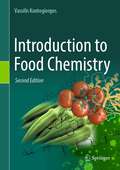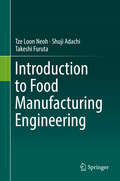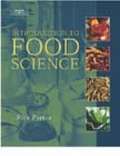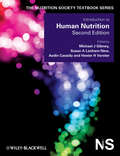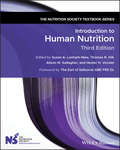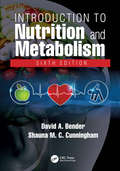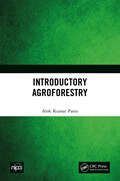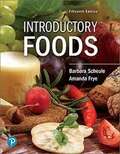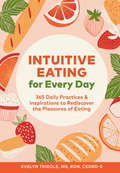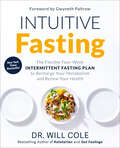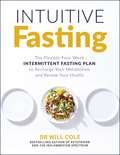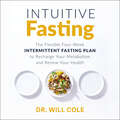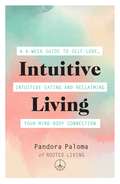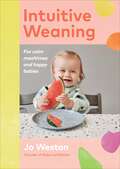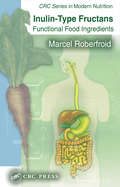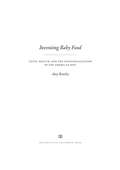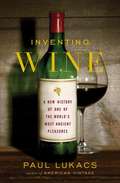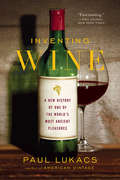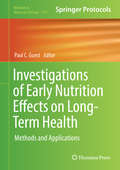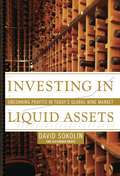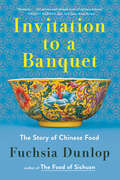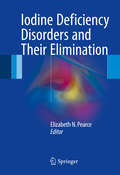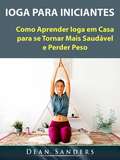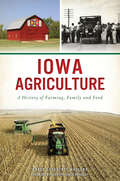- Table View
- List View
Introduction to Food Chemistry
by Vassilis KontogiorgosThe complexity of food chemistry makes it a challenging subject for students studying in a food science course. Although there are excellent food chemistry books available in the market they have two major flaws: they are either encyclopedic or they are not pitched correctly to undergraduate food science students. The first problem creates difficulties for students to identify what is important and how much they need to know. The second problem arises when the book is written by authors that are not food scientists (e.g., chemists), they are not academics that are engaged with teaching or they are not sufficiently qualified to teach. In this case, it is difficult to find links between the chemistry of foods and its relevance to applications or, quite frequently, future employment prospects of the student. Introduction to Food Chemistry, 2nd Edition bridges this gap in the relevant literature, as it employs the latest pedagogical theories in textbook writing to present the subject to students with broad range of cognitive skills. This book presents specific learning objectives for each chapter and is self-contained so students will not need to search for essential information outside the textbook. This new edition has been expanded to include chapters on sweeteners, glass transition, amino acids, proteins for major food commodities and food additives. All of the original chapters have been updated and expanded to include new research and technologies. To support learning, the book has:Didactic elements with information being conveyed with 3D-figures, color-coded schemes and graphs, annotations on figures that link it to the text descriptionsBuilt-in pedagogy and learning activities at the end of each chapter that are linked to the learning objectives.Keywords and concepts for online search to instigate curiosity for further studies.Conversational writing style without losing academic rigorTo support lecturers, the book has:Helps focus teaching preparation on key aspects of food chemistry relevant to both industry and modern research.Aids the preparation of exams, assignments and other types of assessment or learning activities.For lecturers in search of a singular source to aid in their introductory food chemistry courses, look no further than this expanded new edition of Introduction to Food Chemistry.
Introduction to Food Manufacturing Engineering
by Tze Loon Neoh Shuji Adachi Takeshi FurutaThis book provides basic food engineering knowledge for beginners. The discipline of food processing conforms with actual food manufacturing flows and thus is readily comprehensible, although food engineering has great diversity as the common principles of operations for most food manufacturing processes are covered. This volume therefore endeavors to initially embody food manufacturing flows and pays careful attention to quantitatively detailing and explaining the manufacturing operations involved from an engineering point of view. Because this book is intended to be a very basic introductory text for food engineering, it introduces a variety of foods and food ingredients with which the intended readership is familiar to explain comprehensively the fundamental unit operations through the manufacturing flows. Various real foods and food ingredients are used to explain the principles of food engineering so that students of food science, technology, and engineering courses will be able to better grasp the basic concepts. The book includes many exercises for learning how to draw proper graphs and how to deal with mathematical formulas and numerical values. Readers can learn common principles, which are easily applicable to other fields such as pharmaceuticals and biotechnology, through the many examples that are provided.
Introduction to Food Science
by Rick Parker"Introduction to Food Science" provides an overview of the science of foods, from nutrition and digestion to processing and preservation. The material is based on a thorough, easy-to-follow outline that makes developing a lesson plan simple. Each chapter contains a list of learning objectives that help identify important concepts and key words that are essential to the understanding of the material. Tables, charts, graphs and illustrations are inserted throughout the text, providing quick and understandable access to information. The "student activities" section at the end of each chapter provide opportunities to directly apply material. The text also provides insight into career opportunities for those interested in working within food science industries.
Introduction to Human Nutrition
by Susan A. Lanham Michael J. Gibney Aedin Cassidy Hester H. VorsterIn this second edition of the introductory text in the acclaimed Nutrition Society Textbook Series, Introduction to Human Nutrition has been revised and updated to meet the needs of the contemporary student. Introduction to Human Nutrition is an essential purchase for students of nutrition and dietetics, and also for those students who major in other subjects that have a nutrition component, such as food science, medicine, pharmacy and nursing. Professionals in nutrition, dietetics, food science, medicine, health sciences and many related areas will also find much of great value within its covers.
Introduction to Human Nutrition (The Nutrition Society Textbook)
by Hester H. Vorster Susan A. Lanham-New Thomas R. Hill Alison M. GallagherNow in its third edition, the best-selling Introduction to Human Nutrition continues to foster an integrated, broad knowledge of the discipline and presents the fundamental principles of nutrition science in an accessible way. With up-to-date coverage of a range of topics from food composition and dietary reference standards to phytochemicals and contemporary challenges of global food safety, this comprehensive text encourages students to think critically about the many factors and influences of human nutrition and health outcomes. Offers a global, multidisciplinary perspective on food and nutrition Covers nutrition and metabolism of proteins, lipids, carbohydrates and vitamins and minerals Explores new developments in functional foods, supplements and food fortification, and future challenges for nutrition research and practice Explains the digestion, absorption, circulatory transport, and cellular uptake of nutrients Demonstrates the structure and characteristics of nutrients, and the relationship with disease prevention A primary text in nutritional science classes worldwide, Introduction to Human Nutrition is a vital resource for students in areas of nutrition, dietetics, and related subjects that involve principles of nutrition science.
Introduction to Nutrition and Metabolism
by David A Bender Shauna M CunninghamIntroduction to Nutrition and Metabolism equips readers with an understanding of the scientific basis of what we call a healthy diet. Now in its sixth edition, this highly recognized textbook provides clear explanations of how nutrients are metabolized and gives explains the principles of biochemistry needed for comprehending the science of nutrition. This full-color textbook explores the need for food and the uses to which food is put in the body, as well as the interactions between health and diet. Outlining the scientific basis behind nutritional requirements and recommendations, this new edition has been extensively revised to reflect current knowledge. Features: Lists key objectives at the beginning, and key points at the end of each chapter. Accompanying online resources include interactive tutorial exercises based on interpretation of clinical and research data. Covers topics including: Chemical reactions and catalysis by enzymes; the role of ATP; digestion and absorption of carbohydrates, fats and proteins; issues associated with being overweight; problems of malnutrition; diet and health; and vitamin and mineral requirements and functions. Updated sections focus on the interaction of the gut microbiome and epigenetics with our metabolic responses to diet. Provides a foundation of scientific knowledge for the interpretation and evaluation of future advances in nutrition and health sciences. Following its predecessors, this sixth edition is relevant to any student or practitioner interested in how diet influences our health, including in the fields of nutrition, dietetics, medicine and public health.
Introductory Agroforestry
by Alok Kumar PatraThe origin of agroforestry practices—growing trees and shrubs with food and fruit crops and grasses is traditional and very old—but the science of agroforestry is new. Years of experience and experiments have shown that agroforestry as a land-use system is capable of yielding both food and wood and at the same time helps in conserving and rehabilitating the ecosystems. It has the capability to increase the overall productivity of land, maintain the nutrient balance in the soil, and above all, protect the nature. In the recent years, agroforestry has been recommended as a core subject in the curriculum of B. Sc. (Forestry) and B. Sc. (Agriculture) courses of agricultural universities. This book has been divided into ten chapters covering very comprehensive information on all aspects of agroforestry including history, concepts, systems classification, tree-crop interactions, planning and management, diagnosis and design, policy and projects, and propagation and management practices of multipurpose trees. This book is co-published with NIPA. Taylor and Francis does not sell or distribute its print and electronic editions in India, Pakistan, Nepal, Bhutan, Bangladesh and Sri Lanka.
Introductory Foods (What's New in Culinary and Hospitality)
by Barbara Scheule Amanda FryeFor courses in introductory foods, nutrition and dietetics, family and consumer education, and culinary arts management. <p><p> A market-leading introduction to all things food Introductory Foods is a practical, market-leading introduction to the fundamental principles of food preparation. It explores food science and technology, consumption trends, safety issues, government regulations, and the role of food in culture and health. <p><p>A scientific approach to examining the ingredients and techniques used in food service environments makes this a well-rounded resource for courses with food preparation labs. The 15th edition makes food and its science more relevant to the lives of today’s college students, engaging them in discussions of topics such as farm-to-table, commercial and processed food, and vegan food products.
Intuitive Eating for Every Day: 365 Daily Practices & Inspirations to Rediscover the Pleasures of Eating
by Evelyn TriboleAward-winning dietitian, bestselling author, and co-founder of the intuitive eating movement, Evelyn Tribole, offers an inviting and practical introduction to intuitive eating—which Parade calls the "anti-diet to end all diets."Intuitive Eating is a life-changing path to cultivating a healthy relationship with food, mind, and body. Intuitive Eating for Every Day breaks it down for you with daily guidance. This book will be your ally and solace against a world steeped in diet culture. It will illuminate and encourage your Intuitive Eating journey, with 365 practices and inspirations to help you:• Nurture the ten Principles of Intuitive Eating with 52 Weekly Intentions• Connect with your body in the here and now with Grounding practices• Cultivate gratitude for different aspects of nourishment with Meal Meditations• Identify self-trust disruptors and awaken inner knowingness• Strengthen your mental, emotional, and physical health by setting boundaries• Reflect on emotions and cravings• Practice self-compassion, body appreciation, and self-careThese daily readings—read on their own or as a companion to the author's bestselling Intuitive Eating—make it easy to integrate this revolutionary program into your life. Intuitive Eating for Every Day offers constant support to help you make peace with food and reclaim and reconnect with the pleasure of eating.The perfect book for:• Anti-dieters• Fans of Intuitive Eating and The Intuitive Eating Workbook• Anyone looking for daily guidance on a happier and healthier way to eat• Wellness enthusiasts looking for healthy habits• Nutritionists and other health professionals• Mindfulness and meditation practitioners• Certified eating disorder specialists and anyone in eating disorder (ED) recovery
Intuitive Fasting: The Flexible Four-Week Intermittent Fasting Plan to Recharge Your Metabolism and Renew Your Health (Goop Press)
by Dr. Will ColeThe most effective and achievable guide to intermittent fasting, outlining a unique plan that merges the science behind fasting with a holistic approach to eating, from the bestselling author of Ketotarian and The Inflammation Spectrum. &“Intuitive Fasting is Will&’s clear four-week program designed to set you up to feel your best for all the other weeks to come. . . . It&’s full of what he&’s learned about reducing inflammation, restoring balance, recharging metabolism, and resetting gut health.&”—Gwyneth Paltrow, from the forewordFor some, the idea of fasting by eating only one or two meals a day still sounds like an extreme and overly restrictive dieting tactic. But many of us already feel like victims to our daily eating schedule: three meals a day, plus snacks. Eat every few hours, we are told by the experts. This fixed eating schedule has become the norm. The truth is, this is an artificially constructed schedule that does not reflect our bodies&’ natural eating schedule. In fact, eating three meals every day can cause metabolic inflexibility, which can easily lead to inflammation, weight gain, fatigue, and chronic health problems. For millions of years, our bodies have actually functioned best with periodic times of fasting. With his fresh new approach to fasting, bestselling author and functional medicine expert Dr. Will Cole gives us the ability to take control of our hunger, making intermittent fasting intuitive. You&’ll get in touch with your instinctive eating patterns and become healthier and more mindful about how and when you eat. When your body is out of balance, it can be very difficult to discern what it needs to build vibrant wellness. Intuitive Fasting will show you how to find metabolic flexibility—and once you&’ve reached metabolic flexibility, you can intuitively trust your body to function at optimal capacity, whether you&’ve eaten six minutes ago or six hours ago. With his 4-Week Flexible Fasting Plan, Dr. Cole will guide you through varying intermittent fasting windows, with each week of the plan tailored to focus on a different aspect of your health. He illustrates the most effective ways to fast and eat to amplify the health benefits of intermittent fasting, balancing rest and repair with clean, nutrient-dense, delicious foods. By the end of the four weeks, you will have all the tools necessary to Reset your body, Recharge your metabolism, Renew your cells, and Rebalance your hormones. Along with more than sixty-five recipes, you&’ll also find a maintenance plan, so you can adapt fasting and feeding windows to work sustainably with your lifestyle.
Intuitive Fasting: The New York Times Bestseller
by Dr Will Cole'Intuitive Fasting is Will's clear four-week program designed to set you up to feel your best for all the other weeks to come... It's full of what he's learned about reducing inflammation, restoring balance, recharging metabolism, and resetting gut health.' GWYNETH PALTROW, founder and CEO of goopFor some, the idea of fasting by eating only one or two meals a day still sounds like an extreme and overly restrictive dieting tactic. But many of us already feel like victims of our daily eating schedule: three meals a day, plus snacks. The truth is: this is an artificially constructed schedule that does not reflect our bodies' natural cycles. In fact, eating three meals every day can cause metabolic inflexibility, which can easily lead to inflammation, weight gain, fatigue and chronic health problems. For millions of years, our bodies have functioned best with periodic times of fasting. With his fresh approach to fasting, New York Times bestselling author and functional medicine expert Dr Will Cole gives you the ability to take control of your hunger and make intermittent fasting intuitive. You'll get in touch with your instinctive eating patterns and become healthier and more mindful about how and when you eat. Intuitive Fasting will show you how to find metabolic flexibility - and once you've reached it, you can trust your body to function at optimal capacity, whether you've eaten six minutes or six hours ago. During his 4-Week Flexible Fasting Plan, Dr Cole will guide you through varying intermittent fasting windows, with each week of the plan tailored to focus on a different aspect of your health. He demonstrates the most effective ways to fast and eat to amplify the health benefits of intermittent fasting, balancing rest and repair with nutrient dense, delicious foods. By the end of the four weeks, you will have all the tools necessary to:- Reset your body- Recharge your metabolism- Renew your cells- Rebalance your hormonesAlong with more than 65 recipes, you'll find a maintenance plan, so you can adapt fasting and feeding windows to work sustainably with your lifestyle.'If you're looking for a way to recalibrate your body's hunger signals, rebalance your cravings, and comfortably and safely learn how to fast, Intuitive Fasting is a must-read.' ELLE MACPHERSON
Intuitive Fasting: The New York Times Bestseller
by Dr Will ColeFind out how to use the powerful benefits of flexible intermittent fasting to gain metabolic flexibility and find food peace.For some, the idea of fasting by eating only one or two meals a day still sounds like an extreme and overly restrictive dieting tactic. But many of us already feel like victims to our daily eating schedule: three meals a day, plus snacks. Eat every few hours, we are told by the experts. This fixed eating schedule has become the norm. But the truth is this is an artificially constructed schedule that does not reflect our bodies natural and most optimal eating schedule. In fact, eating three meals a day causes metabolic inflexibility, which can easily lead to inflammation, weight gain, and disease.For millions of years, our bodies have actually functioned best by fasting. With his new approach to fasting, bestselling author and functional medicine expert Dr Will Cole gives us the ability to take control of our hunger and makes intermittent fasting intuitive. You'll get in touch with your instinctive eating patterns and become healthier and more mindful about how and when you eat. Intermittent fasting fosters metabolic flexibility and once you've reached metabolic flexibility, you can trust your body to function at optimal capacity, whether you've eaten six minutes ago or six hours ago.With his four-week fasting flexibility plan, Dr Cole will help you reset your body, recharge your metabolism, renew your cells and rebalance your hormones. He'll illustrate the most effective ways to fast and eat to amplify the health benefits of intermittent fasting, balancing rest and repair with clean, nutrient-dense, delicious foods. Along with sixty-five recipes, he also includes a maintenance plan, so you can adapt fasting and feeding windows to work with your lifestyle.'If you're looking for a way to recalibrate your body's hunger signals, rebalance your cravings, and comfortably and safely learn how to fast, Intuitive Fasting is a must-read. Dr Will Cole makes intermittent fasting accessible for everyone, encouraging vibrant health and wellness.' - Elle Macpherson (P) 2021 Penguin Audio
Intuitive Living: A 6-week guide to self-love, intuitive eating and reclaiming your mind-body connection
by Pandora PalomaIt's time to throw away the diet book and start living intuitively. In our increasingly busy world, how to be healthy has become more and more confusing and our relationship with food is ever-changing and often complex. We're bombarded with so many messages that it's causing a disconnect between us and what true health really is: a connection to our body's innate wisdom. In other words, our intuition.This six-week guide introduces the concept that by using our intuition, we can become experts on ourselves and, in turn, learn how to best navigate our own health and happiness. Each week is broken down into steps, giving you the tools and techniques to make the right food and health choices for you. Through celebrating food, encouraging kindness and embracing a positive body image, Holistic Nutritionist and Life Coach, Pandora Paloma takes you on a journey to reconnect with your body and transform your life.
Intuitive Living: A 6-week guide to self-love, intuitive eating and reclaiming your mind-body connection
by Pandora PalomaIt's time to throw away the diet book and start living intuitively. In our increasingly busy world, how to be healthy has become more and more confusing and our relationship with food is ever-changing and often complex. We're bombarded with so many messages that it's causing a disconnect between us and what true health really is: a connection to our body's innate wisdom. In other words, our intuition.This six-week guide introduces the concept that by using our intuition, we can become experts on ourselves and, in turn, learn how to best navigate our own health and happiness. Each week is broken down into steps, giving you the tools and techniques to make the right food and health choices for you. Through celebrating food, encouraging kindness and embracing a positive body image, Holistic Nutritionist and Life Coach, Pandora Paloma takes you on a journey to reconnect with your body and transform your life.
Intuitive Weaning: For calm mealtimes and happy babies
by Jo WestonThe introduction of solids can be a stressful time and parents put a lot of pressure on themselves to 'get it right'. I want to reassure parents that it is easier than they think.Beautifully photographed, this full-colour weaning book has over one hundred super easy and tasty baby and family recipes. It will encourage you to throw away the rule book and wean intuitively, learning to follow your baby's cues and not the clock! Bringing together the author's three R's of weaning - Respectful, Responsive, Realistic - you'll discover that weaning really doesn't have to be a struggle and can be used as a fun learning experience for baby - and you!
Inulin-Type Fructans: Functional Food Ingredients (Modern Nutrition)
by Marcel RoberfroidInulin and oligofructose are naturally occurring resistant carbohydrates that have a variety of uses as functional food ingredients. In addition to their role as prebiotics that selectively stimulate the growth of beneficial bacteria in the intestines, these inulin-type fructans act as dietary fiber in the digestive system and have applications as
Inventing Baby Food
by Amy BentleyFood consumption is a significant and complex social activity--and what a society chooses to feed its children reveals much about its tastes and ideas regarding health. In this groundbreaking historical work, Amy Bentley explores how the invention of commercial baby food shaped American notions of infancy and influenced the evolution of parental and pediatric care. Until the late nineteenth century, infants were almost exclusively fed breast milk. But over the course of a few short decades, Americans began feeding their babies formula and solid foods, frequently as early as a few weeks after birth. By the 1950s, commercial baby food had become emblematic of all things modern in postwar America. Little jars of baby food were thought to resolve a multitude of problems in the domestic sphere: they reduced parental anxieties about nutrition and health; they made caretakers feel empowered; and they offered women entering the workforce an irresistible convenience. But these baby food products laden with sugar, salt, and starch also became a gateway to the industrialized diet that blossomed during this period. Today, baby food continues to be shaped by medical, commercial, and parenting trends. Baby food producers now contend with health and nutrition problems as well as the rise of alternative food movements. All of this matters because, as the author suggests, it's during infancy that American palates become acclimated to tastes and textures, including those of highly processed, minimally nutritious, and calorie-dense industrial food products.
Inventing Wine: A New History of One of the World's Most Ancient Pleasures
by Paul LukacsThe story of how wine, as enjoyed by millions of people today, came to be. Drinking wine can be traced back 8,000 years, yet the wines we drink today are radically different from those made in earlier eras. While its basic chemistry remains largely the same, wine's social roles have changed fundamentally, being invented and reinvented many times over many centuries. In Inventing Wine, Paul Lukacs tells the enticing story of wine's transformation from a source of spiritual and bodily nourishment to a foodstuff valued for the wide array of pleasures it can provide. He chronicles how the prototypes of contemporary wines first emerged when people began to have options of what to drink, and he demonstrates that people selected wine for dramatically different reasons than those expressed when doing so was a necessity rather than a choice. During wine's long history, men and women imbued wine with different cultural meanings and invented different cultural roles for it to play. The power of such invention belonged both to those drinking wine and to those producing it. These included tastemakers like the medieval Cistercian monks of Burgundy who first thought of place as an important aspect of wine's identity; nineteenth-century writers such as Grimod de la Reyniere and Cyrus Redding who strived to give wine a rarefied aesthetic status; scientists like Louis Pasteur and Émile Peynaud who worked to help winemakers take more control over their craft; and a host of visionary vintners who aimed to produce better, more distinctive-tasting wines, eventually bringing high-quality wine to consumers around the globe. By charting the changes in both wine's appreciation and its production, Lukacs offers a fascinating new way to look at the present as well as the past.
Inventing Wine: A New History of One of the World's Most Ancient Pleasures
by Paul Lukacs"Meticulously researched history...look[s] at how wine and Western civilization grew up together." --Dave McIntyre, Washington Post Because science and technology have opened new avenues for vintners, our taste in wine has grown ever more diverse. Wine is now the subject of careful chemistry and global demand. Paul Lukacs recounts the journey of wine through history--how wine acquired its social cachet, how vintners discovered the twin importance of place and grape, and how a basic need evolved into a realm of choice.
Investigations of Early Nutrition Effects on Long-Term Health
by Paul C. GuestThis volume contains several reviews in the field as well as the step-by-step use of targeted and global approaches within the areas of genomics, epigenetics, proteomics, transcriptomics and metabolomics which aim to address this dilemma and to help pinpoint new treatment strategies. Chapters detail the generation of several models and methods for assessing health and provide researchers potential approaches for reversing or minimizing effects of disease. In addition, important information on disease mechanisms is provided, as each method is described in the context of a specific disease or therapeutic area. Written in the highly successful Methods in Molecular Biology series format, the chapters include introductions to their respective topics, lists of the necessary materials and reagents, step-by-step, readily reproducible laboratory protocols, and tips on troubleshooting and avoiding known pitfalls. Authoritative and practical, Investigations of Early Nutrition Effects on Long-Term Health: Methods and Applications aim is to provide insights into the latest ideas and technologies . enabling progress in this field.
Investing in Liquid Assets: Uncorking Profits in Today's Global Wine Market
by David Sokolin Alexandra BruceNow more than ever, the value of Investment-Grade Wines (IGWs) and opportunities to invest in wine as an asset class are soaring. With a little research and a little risk, wine enthusiasts on every level will find it possible to gain big rewards in wine investment -- and there's never been a better time to try. IGWs have dependably outperformed blue chip stocks over the past 150 years, and the upscale wine market is still an area in which independent investors can profit handsomely. A third-generation wine merchant, and CEO of one of the largest rare-wine companies in the world, David Sokolin knows how to turn fine wine into cold cash. And he knows how you can, too. In simple, practical terms, Investing in Liquid Assets provides all the information you need to understand the economic principles that govern the world of fine wine and take advantage of the resources currently available. Using his insider's expertise, Sokolin defines Investment-Grade Wine and identifies the most financially important wine regions and styles. Defining the key players in the field, Sokolin shows you how to navigate the world of wine critics and understand the impact of their scores, and he explains why it's perfectly fine that your own personal tastes really don't matter. He offers tips on where to find reputable sources for fine wine, how to manage storage and resale, as well as all-important buying and selling strategies. In the second half of the book, he gives overviews of the world's greatest wine regions and offers his predictions about which regions and which wines are likely to represent the greatest investment opportunities in the near future. Providing information and tactics previously known only to successful professionals, Investing in Liquid Assets turns your passion for fine wine into a valuable resource that will pay for itself.
Invitation to a Banquet: A History of Chinese Food
by Fuchsia DunlopFinalist for the 2024 IACP Award for Literary or Historical Food Writing An NPR 2023 "Books We Love" Pick • A Food & Wine Best Food Book of 2023 • A Financial Times Best Food and Drink Book of 2023 • One of Smithsonian's Ten Best Books About Food of 2023 The world’s most sophisticated gastronomic culture, brilliantly presented through a banquet of thirty Chinese dishes. Chinese was the earliest truly global cuisine. When the first Chinese laborers began to settle abroad, restaurants appeared in their wake. Yet Chinese has the curious distinction of being both one of the world’s best-loved culinary traditions and one of the least understood. For more than a century, the overwhelming dominance of a simplified form of Cantonese cooking ensured that few foreigners experienced anything of its richness and sophistication—but today that is beginning to change. In Invitation to a Banquet, award-winning cook and writer Fuchsia Dunlop explores the history, philosophy, and techniques of Chinese culinary culture. In each chapter, she examines a classic dish, from mapo tofu to Dongpo pork, knife-scraped noodles to braised pomelo pith, to reveal a distinctive aspect of Chinese gastronomy, whether it’s the importance of the soybean, the lure of exotic ingredients, or the history of Buddhist vegetarian cuisine. Meeting food producers, chefs, gourmets, and home cooks as she tastes her way across the country, Fuchsia invites readers to join her on an unforgettable journey into Chinese food as it is cooked, eaten, and considered in its homeland. Weaving together history, mouthwatering descriptions of food, and on-the-ground research conducted over the course of three decades, Invitation to a Banquet is a lively, landmark tribute to the pleasures and mysteries of Chinese cuisine.
Iodine Deficiency Disorders and Their Elimination
by Elizabeth N. PearceThis volume summarizes the current understanding of the effects of severe and mild-to-moderate iodine deficiency as well as iodine excess. It also discusses best practices for salt iodization, the mainstay of global IDD prevention efforts, and other forms of food fortification. The effectiveness of iodine supplementation for vulnerable populations, an evolving strategy in many regions, is also described. Iodine is an essential micronutrient and an integral component of the thyroid hormones, which are required for normal growth and development. The iodine deficiency disorders (IDD) encompass a spectrum of adverse health effects including goiter, cretinism, hypothyroidism, growth retardation, and increased pregnancy loss and infant mortality. Thyroid hormone is particularly crucial for neurodevelopment in early life. Insufficient maternal iodine intake during pregnancy may result in neurological and cognitive deficits in children. Salt iodization and other preventive strategies have substantially improved iodine nutrition worldwide. Consequently, severely iodine-deficient regions are uncommon at present and public health concern has shifted toward mild-to-moderate iodine deficiency. Despite gains, however, IDD is still considered the leading preventable cause of intellectual impairment worldwide. Excessive iodine intake can cause alterations in thyroid function in susceptible individuals; defining safe upper levels for chronic iodine intake has been challenging. Low-level environmental exposure to chemicals such as perchlorate and thiocyanate which competitively block thyroidal iodine uptake appears to be ubiquitous worldwide. There has been recent concern that such environmental exposures might pose a health hazard by inducing or aggravating underlying thyroid dysfunction. This up-to-date volume explores both the effects of iodine deficiency as well as the best strategies for prevention.
Ioga Para Iniciantes: Como Aprender Ioga em Casa para se Tornar Mais Saudável e Perder Peso
by Dean SandersIoga para iniciantes, Por Dean Sanders Como aprender ioga em casa para se tornar mais saudável e perder peso Você gostaria de ser capaz de acabar com o desconforto, ter menos ansiedade, dormir melhor e com uma mente tranquila, e combater a depressão? Durante muito tempo, as técnicas de ioga têm sido utilizadas para tratar uma série de doenças, nos permitindo viver uma vida mais feliz e saudável! As técnicas de ioga podem nos ajudar a combater não somente doenças crônicas e inflamação como também ajudar a melhorar o sistema imunológico, os níveis de energia, o foco, a felicidade em geral e muito mais! Vivencie emoções mais positivas, e sem depressão. Apresentamos os segredos que profissionais da ioga utilizam para que possamos nos sentir mais saudáveis do que nunca! Com décadas de estratégias testadas, este e-book irá mostrar a maneira mais rápida e eficaz de se utilizar a ioga para beneficiar o seu bem-estar! Este guia ensina técnicas comprovadas sem o uso de suplementos caros ou cursos. O que está incluso: - Para iniciantes. - Fique em forma. - Perca peso. - Torne-se mais flexível. - Combata a depressão. - Combata o estresse. - Reduza e elimine a ansiedade. - Tenha mais energia. - Durma melhor. - Adquira maior consciência. - Supere doenças. + MUITO MAIS! Se você quer ser mais saudável, curar doenças, ou melhorar o foco e o bem-estar, este guia é para você. --> Role até o topo da página e clique em adicionar ao carrinho para comprar Aviso: Este autor e ou o detentor dos direitos autorais não reivindica, assegura ou garante a exatidão, integridade ou adequação das informações disponíveis neste livro e, por conseguinte, rejeita expressamente qualquer responsabilidade por erros ou omissões presentes nele, em razão de ser somente para referência. Por favor, consulte um profissional antes de r
Iowa Agriculture: A History of Farming, Family and Food (American Palate)
by Darcy Dougherty MaulsbyThe Tall Corn State's agricultural history influences countless aspects of modern life. To truly understand Iowa, you have to understand the culture of agriculture--the stories of the people of the land. In many ways, these are untold stories, especially as more generations of families are further removed from living or working on Iowa farms. Visitors from around the globe travel to Iowa annually for major events like the Farm Progress Show, the World Pork Expo and the World Food Prize. Agriculture has shaped Iowa's landscape from the location of towns and the evolution of the world-famous Iowa State Fair to Iowa's beloved culinary traditions like breaded pork tenderloins, sweet corn and more. Join fifth-generation Iowa farmer Darcy Dougherty Maulsby as she details the fascinating history of agriculture in Iowa.
